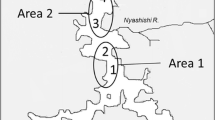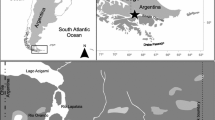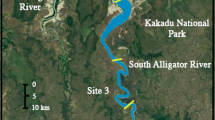Abstract
Small nearshore fishes are an important part of lacustrine and functional diversity and link pelagic and benthic habitats by serving as prey for larger nearshore and offshore fishes. However, the trophic complexity of these small nearshore fishes is often unrecognized and detailed studies of their role in food webs are lacking. Here, we examined niche space patterns of small nearshore fish species using Bayesian analyses of carbon and nitrogen stable isotope data in nine freshwater lakes that are among the largest lakes in Minnesota. We found considerable variability in niche areas within species and high variability in niche overlap across species. At the assemblage level, niche overlap (average diet overlap of all species pairs at a lake) decreased as whole-lake species richness increased, possibly indicating a greater degree of resource specialization in more speciose lakes. Overall fish niche space was weakly but significantly related to niche space of their invertebrate prey. Although nearshore benthic resources contributed to fish diets in all lakes, all fish species also had non-negligible and variable contributions from pelagic zooplankton. This inter- and intraspecific variability in trophic niche space likely contributes to the multi-level trophic complexity, functional diversity, and potentially food web resilience to ecosystem changes.







Similar content being viewed by others
Data availability
The datasets generated and/or analyzed during the current study are available from the corresponding author on reasonable request.
Code availability: Code for analyses were modified from the SIBER and tRophicPosition packages in R: https://CRAN.R-project.org/package=SIBER and https://cran.r-project.org/package=tRophicPosition.
References
Abrams, P., 1983. The theory of limiting similarity. Annual Review of Ecology and Systematics 14: 359–376.
Araújo, M. S., D. I. Bolnick & C. A. Layman, 2011. The ecological causes of individual specialization. Ecology Letters 14: 948–958.
Bajer, P. G., C. J. Chizinski, J. J. Silbernagel & P. W. Sorensen, 2012. Variation in native micro-predator abundance explains recruitment of a mobile invasive fish, the common carp, in a naturally unstable environment. Biological Invasions 14: 1919–1929.
Bearhop, S., C. E. Adams, S. Waldron, R. A. Fuller & H. Macleod, 2004. Determining trophic niche width: a novel approach using stable isotope analysis. Journal of Animal Ecology 73: 1007–1012.
Becker, G. C., 1983. Fishes of Wisconsin. University of Wisconsin Press, Madison.
Bolnick, D. I., R. Svanbäck, J. A. Fordyce, L. H. Yang, J. M. Davis, C. D. Hulsey & M. L. Forister, 2003. The ecology of individuals: incidence and implications of individual specialization. American Naturalist 161: 1–28.
Brown, A. F. & M. Diamond, 1984. The consumption of rainbow trout (Salmo gairdneri Richardson) eggs by macroinvertebrates in the field. Freshwater Biology 14: 211–215.
Burks, R. L., E. Jeppesen & D. M. Lodge, 2001. Pelagic prey and benthic predators: the impact of odonates on Daphnia. Journal of the North American Benthological Society 20: 615–628.
Burks, R. L., D. M. Lodge, E. Jeppesen & T. L. Lauridsen, 2002. Diel horizontal migration of zooplankton: costs and benefits of inhabiting the littoral. Freshwater Biology 47: 343–365.
Connell, J. H, 1983. On the prevalence and relative importance of interspecific competition: evidence from field experiments. The American Naturalist 122: 661–696.
Copp, G. H., J. R. Britton, Z. Guo, V. R. Edmonds-Brown, J. Pegg, L. Vilizzi & P. I. Davison, 2017. Trophic consequences of non-native pumpkinseed Lepomis gibbosus for native pond fishes. Biological Invasions 19: 25–41.
Creque, S. M. & S. J. Czesny, 2012. Diet overlap of non-native alewife with native yellow perch and spottail shiner in nearshore waters of southwestern Lake Michigan, 2000–2007. Ecology of Freshwater Fish 21: 207–221.
Curtis, J. S., K. R. Wall, M. A. Albins & C. D. Stallings, 2017. Diet shifts in a native mesopredator across a range of invasive lionfish biomass. Marine Ecology Progress Series 573: 215–228.
Davies, J., 1985. Evidence for a diurnal horizontal migration in Daphnia hyalina lacustris Sars. Hydrobiologia 120: 103–105.
Emmerson, M. C. & J. M. Yearsley, 2004. Weak interactions, omnivory and emergent food-web properties. Proceedings of the Royal Society of Biological Sciences 271: 397–405.
Etnier, D. A. & W. C. Starnes, 1993. The Fishes of Tennessee. The University of Tennessee Press, Knoxville.
Fayram, A. H., M. J. Hansen & T. J. Ehlinger, 2005. Interactions between Walleyes and four fish species with implications for Walleye stocking. North American Journal of Fisheries Management 25: 1321–1330.
Feiner, Z. S., C. J. Foley, R. K. Swihart, H. Bootsma, S. Czesny, J. Janssen, J. Rinchard & T. O. HööK, 2019. Individual and spatial variation are as important as species‐level variation to the trophic complexity of a lentic food web. Ecology of Freshwater Fish 28: 516–532.
Froese, R. & D. Pauly (eds), 2019. FishBase [available on internet at www.fishbase.org].
Fry, B., 1991. Stable isotope diagrams of freshwater food webs. Ecology 72: 2293–2297.
Gause, G. F., 1934. The Struggle for Existence. Williams & Wilkins, Baltimore.
Gerking, S., 1994. Feeding Ecology of Fish. Academic, San Diego.
Hardin, G., 1960. The competitive exclusion principle. Science 131: 1292–1297.
Hirvonen, H., 1999. Shifts in foraging tactics of larval damselflies: effects of prey density. Oikos 86: 443–452.
Hulsman, M. F., C. L. Cahill, A. C. Erwin, B. D. Lunn, W. M. Tonn, K. L. Howland & A. B. M. Bakix, 2016. Influence of potential fish competitors on Lake Trout trophic ecology in small lakes of the Barrenlands, N.W.T., Canada. Journal of Great Lakes Research 42: 290–298.
Huxel, G. R. & K. McCann, 1998. Food web stability: the influence of trophic flows across habitats. The American Naturalist 152: 460–469.
Jackson, A. L., R. Inger, A. C. Parnell & S. Bearhop, 2011. Comparing isotopic niche widths among and within communities: SIBER – stable isotope Bayesian ellipses in R. Journal of Animal Ecology 80: 595–602.
Jackson, A. & A. C. Parnell, 2019. Package SIBER. R package version 2.1.4.
Jirka, K. J. & C. E. Kraft, 2017. Diet niche width and individual specialization of brook trout in Adirondack Lakes. Transactions of the American Fisheries Society 146: 716–731.
Johnson, J. H. & D. S. Dropkin, 1993. Diel variation in diet composition of a riverine fish community. Hydrobiologia 271: 149–158.
Kaymak, N., K. O. Winemiller, S. Akin, Z. Altuner, F. Polat & T. Dal, 2018. Spatial and temporal variation in food web structure of an impounded river in Anatolia. Marine and Freshwater Research 69: 1453–1471.
Keast, A., 1968. Feeding biology of the black crappie, Pomoxis nigromaculatus. Journal of the Fisheries Research Board of Canada 25: 285–297.
Knudsen, R., A. P. Eloranta, A. Siwertsson, R. A. Paterson, M. Power & O. T. Sandlund, 2019. Introduction of Mysis relicta (Mysida) reduces niche segregation between deep-water Arctic charr morphs. Hydrobiologia 840: 245–260.
Kratina, P., R. M. LeCraw, T. Ingram & B. R. Anholt, 2012. Stability and persistence of food webs with omnivory: is there a general pattern? Ecosphere 3: 50.
Lauridsen, T. L. & I. Buenk, 1996. Diel changes in the horizontal distribution of zooplankton in the littoral zone of two shallow eutrophic lakes. Archiv für Hydrobiologie 137: 167–176.
Layman, C. A., D. A. Arrington, C. G. Montana & D. M. Post, 2007a. Can stable isotope ratios provide for community-wide measures of trophic structure? Ecology 88: 42–48.
Layman, C. A., J. P. Quattrochi, C. M. Peyer, J. E. Allgeier & K. Suding, 2007b. Niche width collapse in a resilient top predator following ecosystem fragmentation. Ecology Letters 10: 937–944.
Leigh, E. G., 1990. Community diversity and environmental stability: a reexamination. Trends in Ecology and Evolution 5: 340–344.
MacDougall, A. S., E. Harvey, J. L. McCune, K. A. Nilsson, J. Bennett, J. Firn, T. Bartley, J. B. Grace, J. Kelly, T. D. Tunney, B. McMeans, S.-I. S. Matsuzaki, T. Kadoya, E. Esch, K. Cazelles, N. Lester & K. S. McCann, 2018. Context-dependent interactions and the regulation of species richness in freshwater fish. Nature Communications 9: 973.
Mason, N. W. H., P. Irz, C. Lanoiselée, D. Mouillot & C. Argillier, 2008. Evidence that niche specialization explains species–energy relationships in lake fish communities. Journal of Animal Ecology 77: 285–296.
Matthews, B. & A. Mazumder, 2004. A critical evaluation of intrapopulation variation of δ13C and isotopic evidence of individual specialization. Oecologia 140: 361–371.
Mazumder, D., R. J. Williams, L. Wen, N. Saintilan & C. T. Walsh, 2016. Impoundment constraint of fish niche diversity in a temperate Australian river. Hydrobiologia 771: 195–206.
MacArthur, R. H. & R. Levins, 1967. The limiting similarity, convergence, and divergence of coexisting species. The American Naturalist 101: 377–385.
McCann, K. & A. Hastings, 1997. Re-evaluating the omnivory–stability relationship in food webs. Proceedings of the Royal Society of Biological Sciences 264: 1249–1254.
McMeans, B. C., K. S. McCann, T. D. Tunney, A. T. Fisk, A. M. Muir, N. Lester, B. Shuterand & N. Rooney, 2016. The adaptive capacity of lake food webs: from individuals to ecosystems. Ecological Monographs 86: 4–19.
Merritt, R. W., K. W. Cummins & M. B. Berg, 2008. An Introduction to the Aquatic Insects of North America, 4th ed. Kendall Hunt, Dubuque.
Murdy, E. O., R. S. Birdsong & J. A. Musick, 1997. Fishes of Chesapeake Bay. Smithsonian Institution Press, London.
Myers, P., R. Espinosa, C. S. Parr, T. Jones, G. S. Hammond & T. A. Dewey, 2020. The Animal Diversity Web [available on internet at https://animaldiversity.org].
Newsome, S. D., C. Martinez del Rio, S. Bearhop & D. L. Phillips, 2007. A niche for isotopic ecology. Frontiers in Ecology and the Environment 5: 429–436.
Olsson, K., P. Stenroth, P. Nystrom & W. Graneli, 2009. Invasions and niche width: does niche width of an introduced crayfish differ from a native crayfish? Freshwater Biology 54: 1731–1740.
Parke, A. D., D. G. Uzarski, C. R. Ruetz III & T. M. Burton, 2009. Diets of Yellow Perch (Perca flavescens) in wetland habitats of Saginaw Bay, Lake Huron. Journal of Freshwater Ecology 24: 347–355.
Parreira de Castro, D. M., D. Reis de Carvalho, P. Pompeu, M. Z. Moreira, G. B. Nardoto & M. Callisto, 2016. Land use influences niche size and the assimilation of resources by benthic macroinvertebrates in tropical headwater streams. PLoS ONE 11: e0150527.
Plummer, M., N. Best, K. Cowles & K. Vines, 2006. CODA: convergence diagnosis and output analysis for MCMC. R News 6: 7–11.
Quevedo, M., R. Svanbäck & P. Eklöv, 2009. Intrapopulation niche partitioning in a generalist predator limits food web connectivity. Ecology 90: 2263–2274.
Quezada-Romegialli, C. & A. Jackson, 2018. clquezada/tRophicPosition: pre CRAN v0.7.5 release (Version v0.7.5). Zenodo. http://doi.org/https://doi.org/10.5281/zenodo.1161826.
R Core Team, 2019. R: A Language and Environment for Statistical Computing. R Foundation for Statistical Computing, Vienna [available on internet at https://www.R-project.org/].
Ricklefs, R. E., 2010. Evolutionary diversification, coevolution between populations and their antagonists, and the filling of niche space. Proceedings of the National Academy of Sciences of USA 107: 1265–1272.
Rooney, N., K. S. McCann, G. Gellner & J. C. Moore, 2006. Structural asymmetry and the stability of diverse food webs. Nature 442: 265–269.
Rooney, N. & K. S. McCann, 2012. Integrating food web diversity, structure and stability. Trends in Ecology and Evolution 27: 40–46.
Sargeant, B. L., 2007. Individual foraging specialization: niche width versus niche overlap. Oikos 116: 1431–1437.
Scott, W. & E. Crossman, 1973. Freshwater fishes of Canada. Bulletin of the Fisheries Research Board of Canada 184: 1–966.
Stansfield, J. H., M. R. Perrow, L. D. Tench, A. J. D. Jowitt & A. A. L. Taylor, 1997. Submerged macrophytes as refuges for grazing Cladocera against fish predation: observations on seasonal changes in relation to macrophyte cover and predation pressure. Hydrobiologia 342/343: 229–240.
Stasko, A. D., T. A. Johnston & J. M. Gunn, 2015. Effect of water clarity and other environmental factors on trophic niches of two sympatric piscivores. Freshwater Biology 60: 1459–1474.
Strayer, D. L. & S. E. G. Findlay, 2010. Ecology of freshwater shore zones. Aquatic Science 72: 127–163.
Taylor, N. G. & A. M. Dunn, 2017. Size matters: predation of fish eggs and larvae by native and invasive amphipods. Biological Invasions 19: 89–107.
Simon, T. P., 1998. Assessing the Sustainability and Biological Integrity of Water Resources Using Fish Communities. CRC Press, Boca Raton.
Toussaint, A., N. Charpin, S. Brosse & S. Villéger, 2016. Global functional diversity of freshwater fish is concentrated in the Neotropics while functional vulnerability is widespread. Scientific Reports 6: 1–9.
Trebitz, A. S. & J. C. Hoffman, 2015. Coastal wetland support of Great Lakes fisheries: progress from concept to quantification. Transactions of the American Fisheries Society 144: 352–372.
Vallina, S. M. & C. Le Quéré, 2011. Stability of complex food webs: resilience, resistance and the average interaction strength. Journal of Theoretical Biology 272: 160–173.
Vadeboncoeur, Y., M. J. Vander Zanden & D. M. Lodge, 2002. Putting the lake back together: reintegrating benthic pathways into lake food web models. BioScience 52: 44–54.
Vadeboncoeur, Y., E. Jeppesen, J. Van der Zanden, H. Schierup, K. Christoffersen & D. M. Lodge, 2003. From Greenland to green lakes: cultural eutrophication and the loss of benthic pathways in lakes. Limnology and Oceanography 48: 1408–1418.
Vadeboncoeur, Y., P. B. McIntyre & M. J. Vander Zanden, 2011. Borders of biodiversity: life at the edge of the world’s large lakes. BioScience 61: 526–537.
Vander Zanden, M. J. & Y. Vadeboncoeur, 2002. Fishes as integrators of benthic and pelagic food webs in lakes. Ecology 83: 2152–2161.
Vander Zanden, M. J., M. K. Clayton, E. K. Moody, C. T. Solomon & B. C. Weidel, 2015. Stable isotope turnover and half-life in animal tissues: a literature synthesis. PLoS ONE 10: e0116182.
Villéger, S., G. Grenouillet & S. Brosse, 2014. Change in functional β‐diversity. Global Ecology and Biogeography 23: 1450–1460.
Walls, M., M. Rajasilta, J. Sarvala & J. Salo, 1990. Diel changes in horizontal microdistribution of littoral cladocera. Limnologica 20: 253–258.
Weidel, B. C., S. R. Carpenter, J. F. Kitchell & M. J. Vander Zanden, 2011. Rates and components of carbon turnover in fish muscle: insights from bioenergetics models and a whole-lake 13C addition. Canadian Journal of Fisheries and Aquatic Sciences 68: 387–399.
Werner, E. E. & D. J. Hall, 1976. Niche shifts in sunfishes: experimental evidence and significance. Science 191: 404–406.
Winemiller, K. O., E. R. Pianka, L. J. Vitt & A. Joern, 2001. Food web laws or niche theory? Six independent empirical tests. The American Naturalist 158: 193–199.
Wootton, K. L., 2017. Omnivory and stability in freshwater habitats: does theory match reality? Freshwater Biology 62: 821–832.
Wuellner, M. R., B. D. S. Graeb, D. W. Willis, B. J. Galster, T. M. Selch & S. R. Chipps, 2011. Competitive interactions between walleye (Sander vitreus) and smallmouth bass (Micropterus dolomieu) under various controlled conditions. Journal of Freshwater Ecology 26: 299–314.
Zimmer, K. D., R. C. Grow, A. R. Tipp, B. R. Herwig, D. F. Staples, J. B. Cotner & P. C. Jacobson. 2020. Stable isotope patterns in lake food webs reflect productivity gradients. Ecosphere 11(9): e03244. https://doi.org/10.1002/ecs2.3244.
Acknowledgements
We thank Jaime LeDuc, Ryan Maki, Will French, Robert Hell, Matthew Santo, and Jodie Hirsch for field and laboratory assistance. We also acknowledge Minnesota Department of Natural Resources staff who collected and processed samples used for this analysis. We thank the editor and two anonymous reviewers for suggestions that greatly improved the manuscript. This paper is contribution number 640 from the Natural Resources Research Institute-University of Minnesota Duluth (NRRI-UMD).
Funding
Funding for this research was provided by the Minnesota Environmental and Natural Resources Trust Fund as recommended by the Minnesota Aquatic Invasive Species Research Center (MAISRC) and the Legislative-Citizen Commission on Minnesota Resources (LCCMR), and NRRI-UMD.
Author information
Authors and Affiliations
Contributions
Not applicable.
Corresponding author
Ethics declarations
Conflict of interest
The authors declare no conflict of interest.
Additional information
Handling editor: Maria de los Angeles Gonzalez Sagrario
Publisher's Note
Springer Nature remains neutral with regard to jurisdictional claims in published maps and institutional affiliations.
Supplementary Information
Below is the link to the electronic supplementary material.
10750_2021_4570_MOESM1_ESM.eps
Supplemental Information Fig. 1 Isotopic niche areas (SEA) for species at each lake and percent niche overlap. Standard ellipse areas contain 95% of the data for each fish species present at each lake. a) Mille Lacs (ML), Cass (CAS), Winnibigoshish (WIN), Kabetogama (KAB), Lake of the Woods (LOW). b) Rainy (RAIN), Vermilion (VERM), Leech (LEC), and Upper and Lower Red Lakes (Red). Tables represent the percent niche overlap between each species present in a lake. Note: not all species were collected in each lake. Fish species include: YOY black crappie (BLC), bluntnose minnow (BNM), YOY smallmouth bass (SMB), YOY largemouth bass (LMB), Johnny darter (JND), spottail shiner (SPO), white sucker (WTS), YOY yellow perch (YEP) (EPS 8521 kb)
10750_2021_4570_MOESM2_ESM.eps
Supplemental Information Fig. 2 Relationship between invertebrate prey niche areas (SEAb modes) and proportion of invertebrate niche area used by fish (fish/invertebrate SEAb modes ± 95% credibility intervals) at each lake for individual fish species. We present p-values and correlation coefficients (r) when significant. Lakes include: Cass (CAS), Kabetogama (KAB), Leech (LEC), Lake of the Woods (LOW), Mille Lacs (ML), Rainy (RAIN), Upper and Lower Red Lakes (RED), Vermilion (VERM), and Winnibigoshish (WIN). A smaller proportion of the invertebrate niche area is used by some fish species as invertebrate niche space gets larger, although the relationship is only significant for white sucker. Fish species include: YOY black crappie (BLC), bluntnose minnow (BNM), YOY smallmouth bass (SMB), YOY largemouth bass (LMB), Johnny darter (JND), spottail shiner (SPO), white sucker (WTS), YOY yellow perch (YEP) (EPS 2008 kb)
Rights and permissions
About this article
Cite this article
Wellard Kelly, H.A., Kovalenko, K.E., Ahrenstorff, T.D. et al. Trophic complexity of small fish in nearshore food webs. Hydrobiologia 848, 2505–2521 (2021). https://doi.org/10.1007/s10750-021-04570-5
Received:
Revised:
Accepted:
Published:
Issue Date:
DOI: https://doi.org/10.1007/s10750-021-04570-5




